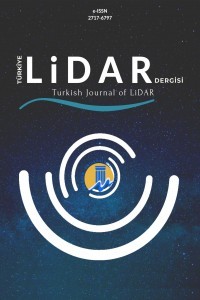Hybrid Modeling of Adamkayalar Reliefs
Throughout history, many civilizations with different ethnic and national values have lived in Anatolia. In many parts of Turkey's possible to encounter this civilization's cultural heritage. Cultural heritages in the world; until today, it has been affected by natural events such as earthquakes, floods and fire. These have been completely or partially destroyed as a result of human activities. Cultural heritage is very precious to people and assurance. Quick and practical documentation is of great importance to this. Various methods are used for this documentation process. Among these methods, terrestrial laser scanning (TLS) and Unmanned Aerial Vehicle (UAV) photogrammetry are frequently preferred techniques in recent years. Both methods ensure recording cultural heritages and producing 3D realistic models. It is not always easy to collect data in places with cultural value because of their historical importance and location. At this juncture, the use of terrestrial laser scanners and UAVs makes an important contribution to the documentation of cultural heritage. This study aims to examine the Adamkayalar reliefs, by using TLS and UAV photogrammetry. By processing the data obtained from both methods, a 3D model of the study area was produced and the results were evaluated.
___
- Aliefendioğlu Y & Tanrıvermiş H (2011). Türkiye’de Çevre Koruma Alanlarında arazi kullanımı ve Koruma Kararlarının Arazi Piyasalarına Etkileri: Gökova Özel Çevre Koruma Bölgesi Örneği. Üçüncü Sektör Kooperatifçilik, 46 (1), 64-102.
- Barber D, Mills J & Bryan P G (2001). Laser Scanning and Photogrametry: 21st century metrology. 18-21 Semptember, 360-366. Potsdam, Germany.
- Beg A A (2018). 3 Boyutlu Modellemede Yersel Lazer Tarama ve İnsansız Hava Araçları Verilerinin Entegrasyonu ve Kilistra Antik Kenti Örneği. Yüksek Lisans Tezi, T.C. Selçuk Üniversitesi, Fen Bilimleri Enstitüsü, Konya.
- Çelik M Ö, Yakar İ, Hamal S N G, Oğuz G M & Kanun E (2020). Sfm Tekniği ile Oluşturulan 3B Modellerin Kültürel Mirasın Belgelenmesi Çalışmalarında Kullanılması: Gözne Kalesi Örneği. Türkiye İnsansız Hava Araçları Dergisi, 2 (1), 22-27.
- Çevre ve Şehircilik Bakanlığı (ÇŞB) (2006). Türkiye Korunan Alanlar Yönetim Planlaması Rehberi.
- Chandler J H, Bryan P & Fryer J G (2007). The development and application of a simple methodology for recording rock art using consumer-grade digital cameras. The Photogrammetric Record, 22 (117), 10–21.
- Çoruhlu Y E, Çelik M Ö, Demir O & Yıldız O (2017). Korunan Alanların Arazi Yönetiminde CBS Uygulamaları. 1(1), 1-7.
- Dellaert F, Seitz S M, Thorpe C E & Thrun S (2000). Structure from motion without correspondence. Proceedings. IEEE Conference on Computer Vision and Pattern Recognition, CVPR 2000 (Cat. No.PR00662), Hilton Head Island, SC, 557-564 Vol. 2, doi:10.1109/CVPR.2000.854916
- Deniz S, Öktem S, Kırbaş İ & Tarkan D (2017). Alansal/Yersel Lazer Tarayıcıların Arkeolojik Mekânların Fiziki Özelliklerinin Tespitinde Kullanılması: Kibrya Antik Kenti Odeon Yapısı Sahne Duvarı Örneği. Mehmet Akif Ersoy Üniversitesi Fen Bilimleri Enstitüsü Dergisi, 8 (1), 211-217.
- El-Hakim S F (2001). A flexible approach to 3D reconstruction from single images ACM Proceedings of SIGGRAPH ’01, Technical Sketches, Los Angeles, California, 12th to 17th August 2001. 280 pages: 186.
- Katarína P, Karol B, Pavel B, Juraj G, Peter B & L’udovít K (2020). Surveying and High-Resolution Topography of the Ochtiná Aragonite Cave Based on TLS and Digital Photogrammetry, 10 (13)
- Koca R, Güney İ, Öncü M A & Somuncu M (2016). A research on effective planning and sustainable area management in protected areas: Case of Kaçkar Mountains National Park International Geography Symposium, 13-14 October 2016, Ankara.
- Kolzenburg S, Favalli M, Fornaciai A, Isola I, Harris A J L, Nannipieri L & Giordano D (2016). Rapid updating and improvement of airborne lidar DEMs through ground-based sfm 3-d modelling of volcanic features. IEEE Transactions on Geoscience and Remote Sensing, 54 (11), 6687-6699
- Kültür Portalı (2020). https://www.kulturportali.gov.tr/turkiye/mersin/gezilecekyer/adamkayalar
- Parrot, 2020 https://www.parrot.com/us/drones/anafi
- Sabuncu A & Özener H (2020). Mimari Dökümantasyonda Yersel Lazer Tarama Teknolojisi Kullanımı: Tarihi Sismoloji Binası Örneği,1(1): 45-52
- Sarıtürk B & Şeker D Z (2017). SFM Tekniği ile 3B Obje Modellenmesinde Kullanılan Ticari ve Açık-Kaynak Kodlu Yazılımların Karşılaştırılması. Afyon Kocatepe Üniversitesi Fen ve Mühendislik Bilimleri Dergisi, Özel Sayı, 126-131.
- Sensefly, 2020 https://www.sensefly.com/drone/ebee-mapping-drone/)
- Simón P, Mariluz G & Juan O (2018). 3-D Modeling of Historic Façades Using SFM Photogrammetry Metric Documentation of Different Building Types of a Historic Center.
- Snavely N (2008). Scene reconstruction and visualization from Internet photo collections, unpublished PhD thesis, University of Washington, USA.
- Ulvi A & Yakar M (2014). Yersel Lazer Tarama Tekniği Kullanarak Kızkalesi’nin Nokta Bulutunun Elde Edilmesi ve Lazer Tarama Noktalarının Hassasiyet Araştırması. Electronic Journal of Map Technologies, 6 (1), 25-36.
- Ulvi A & Yiğit A Y (2019). Kültürel Mirasın Dijital Dokümantasyonu: Taşkent Sultan Çeşmesinin Fotogrametrik Teknikler Kullanarak 3B Modelinin Yapılması. Türkiye Fotogrametri Dergisi, 1 (1), 1-6.
- Ulvi A, Yakar M, Yiğit A & Kaya Y (2019). The Use of Photogrammetric Techniques in Documenting Cultural Heritage: The Example of Aksaray Selime Sultan Tomb. Universal Journal Of Engineering Science, 7(3), 64-73.
- Ulvi A, Yakar M, Yiğit A Y & Kaya Y (2020) İHA ve Yersel Fotogrametrik Teknikler Kullanarak Aksaray Kızıl Kilise’nin 3 Boyutlu Nokta Bulutu ve Modelinin Üretilmesi. Geomatik Dergisi, 5 (1), 19-26
- Uslu A & Uysal M (2017). Arkeolojik Eserlerin Fotogrametri Yöntemi İle 3 Boyutlu Modellenmesi: Demeter Heykeli Örneği, 2(2), 60-65
- Westoby M J, Brasington J, Glasser N F, Hambrey M J, Reynolds J M (2012). Structure-from-Motion photogrammetry: A low-cost, e ective tool for geoscience applications. Geomorphology, 179, 300–314.
- Başlangıç: 2019
- Yayıncı: Mersin Üniversitesi
Sayıdaki Diğer Makaleler
Lidar Sistemlerinin Karşılaştırmalı Doğruluk Analizi
Ramazan Alper KUÇAK, Serdar EROL, Mehmet İŞİLER
Kentsel Yeşil Alan Kalitesinin LiDAR Nokta Bulutu Verileri Kullanılarak Haritalanması
Binnaz SARI, Seda Nur Gamze HAMAL, Ali ULVİ
İldeniz Leyla ÖZTÜRK, Mehmet Özgür ÇELİK, Erkan BAYGÜL
Mobil LiDAR Nokta Bulutlarından Enerji Nakil Hatlarının Doğrusal Olmayan Modellerle Kestirimi
